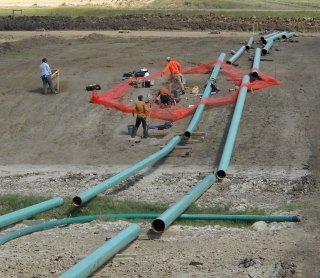Before pipelines can be constructed and come online, they often require a host of permitting services and environmental studies.
SWCA was hired to provide input on routing and pre-construction delineations of wetlands and waters of the U.S., cultural resource surveys, and threatened and endangered species assessments for a natural gas liquids pipeline stretching 720 miles to connect wells in the Permian Basin and Eagle Ford Shale formation to fractionation plants along the Texas Gulf Coast.
The surveys ultimately determined that the pipeline could be constructed with authorization under Nationwide Permit 12 (for utility line activities) as required by Section 404 of the Clean Water Act. By breaking the project up into segments, several segments could proceed under Nationwide Permit 12 without delays to construction. The remaining segments were permitted with agency involvement. SWCA worked closely with the company to conduct the necessary resource surveys and provide assessment and compliance documents to the U.S. Army Corps of Engineers (USACE), U.S. Fish and Wildlife Service (USFWS), and Texas Historical Commission.
Avoiding Natural and Cultural Resource Obstacles
SWCA worked with the pipeline company during the early planning stage to route the pipeline around significant environmental obstacles, such as the Edwards Aquifer, which is the source of drinking water for the city of San Antonio and other municipalities and supports many federally listed aquatic species. By avoiding the aquifer, the client avoided the potential for construction delays to result from land-use restrictions and the need to assuage agency concerns regarding the threat of aquifer impacts.
Once it was time for SWCA biologists and archaeologists to hike the alignment nearly all the way across the state of Texas, the survey findings revealed a high density of cultural resource sites and endangered species in some areas.
SWCA archaeologists discovered several potentially significant cultural resource sites and one buried stratified Archaic and Late Prehistoric camp site in Frio County. The pipeline company followed the advice of SWCA and rerouted around these sites or chose to horizontal directional drill beneath them to obtain project approval from the Texas Historical Commission, thus avoiding construction delays.
One of the largest cultural resources sites, however, was situated in such a way that, given other constraints, complete avoidance was impossible. In response to this, SWCA performed significance testing that was able to drastically reduce the size of the site that warranted avoidance. Such a strategy allowed the company to maintain the pipeline course with minimal horizontal directional drill length, minimal impact to the site, and management of the resource for maximum benefit to the satisfaction of all parties.
Reducing Endangered Species Impacts
SWCA’s natural resources team conducted presence/absence surveys for the federally endangered Tobusch fishhook cactus (Sclerocactus brevihamatus ssp. tobuschii). The status and distribution of this cactus is imperfectly known because most land in Texas is privately held and generally inaccessible to researchers. The cactus occurs only in a very small region in southwest Texas and the pipeline route created a nearly perfect transect across its range. SWCA biologists had no idea what to expect when they started the surveys and were surprised to find approximately 100 of the endangered cacti in the narrow construction corridor. Surveys in two counties crossed by the pipeline contributed to knowledge regarding abundance of the cactus and a potential hybridization zone with Sclerocactus brevihamatus ssp. brevihamatus. To avoid impacts to the endangered species, SWCA teams excavated all of the Tobusch fishhook cacti from the project right-of-way. They now reside at the Ladybird Johnson Wildflower Center in Austin, where they are being cared for and propagated for seed collection. They will be replanted in the wild once a suitable location is identified.
SWCA biologists also conducted presence/absence surveys for the federally endangered black-capped-vireo (Vireo atricapilla) and golden-cheeked warbler (Setophaga chrysoparia). Few data were available regarding the status of these birds in Edwards and Kinney counties and SWCA surveys provided valuable distribution data for the species.
The surveys also showed fewer impacts than expected after initial habitat assessments showed a potential for more of the birds to occur there. Along with minimization measures – such as reducing the width of the construction corridor in the birds’ habitat areas and timing clearing activities for winter when the birds are absent – SWCA facilitated an agreement for the client to compensate for habitat impacts through the purchase of credits from warbler and vireo conservation banks. Purchasing credits from conservation banks — rather than creating a new conservation area — was a win for both the client and the species. The client benefitted in getting more efficient closure on the project without the need to own and maintain preservation land in perpetuity. The species benefited from having a larger contiguous amount of land set aside for habitat enhancement and protection instead of small, scattered habitat areas that are less suitable as long-term preserves.
Expediting Permits
The USACE and USFWS examined the pipeline’s route through listed species’ habitat to evaluate whether the project would need to undergo an Endangered Species Act Section 7 consultation as well as obtain a Section 10 permit from the USFWS. SWCA worked with the agencies and provided the scientific data necessary to enable a Section 7 consultation between the USACE and USFWS for all of the expected project impacts. Avoiding the need for a Section 10 permit reduced the permitting timeline by at least a year. The pipeline company received nationwide permit authorization within five months of the USACE initiating Section 7 consultation with the USFWS.
The project was a success for all parties involved. The science that SWCA provided and the conservation measures that the client funded gave the agencies the assurance they needed to issue permits without delay. The agencies had sufficient proof that the project would cause only minimal impacts to protected resources, and those impacts would be offset by effective conservation banking. In addition, pipeline construction could proceed on schedule without any long-term commitments for managing or maintaining habitat.
